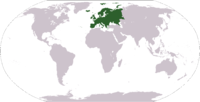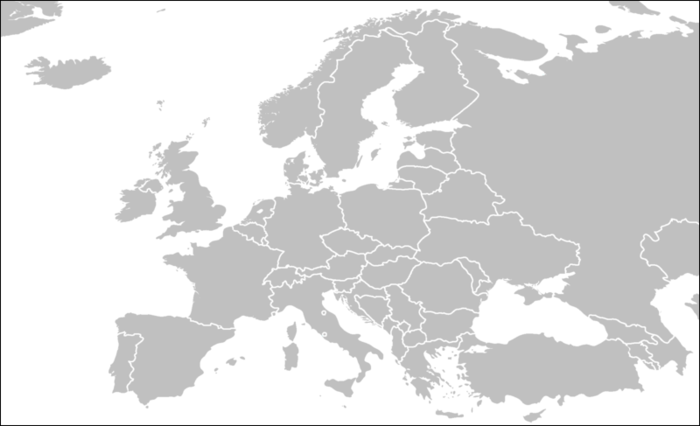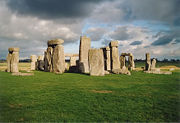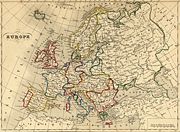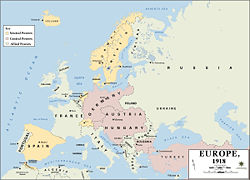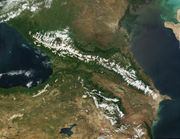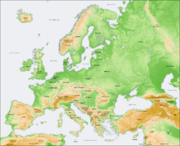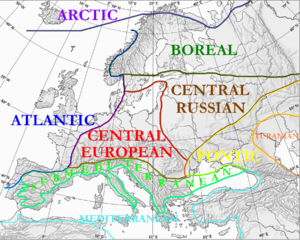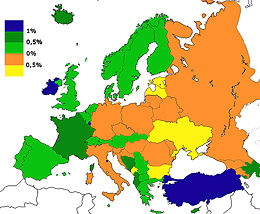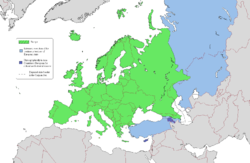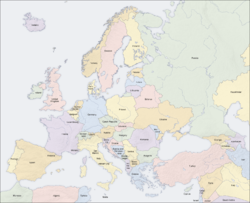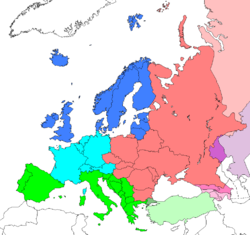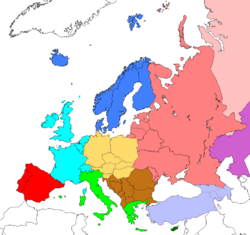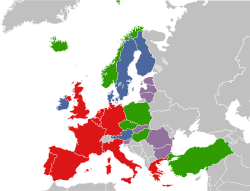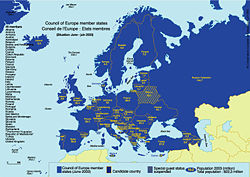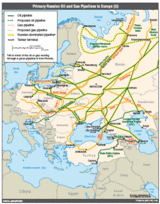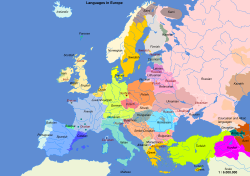Europe
2008/9 Schools Wikipedia Selection. Related subjects: European Geography
Europe
| Area | 10,180,000 km² (3,930,000 sq mi) |
|---|---|
| Population | 731,000,000 |
| Density | 70/km² (181/sq mi) |
| Countries | ca. 50 |
| Demonym | European |
| Language families | Indo-European Finno-Ugric Turkic Basque Semitic Northwest Caucasian Northeast Caucasian Mongolic |
| Largest Cities | Istanbul, Moscow, London, Paris, Madrid, Barcelona, Saint Petersburg, Milan, Berlin, Rome, Athens |
| Time Zones | UTC (Iceland) to UTC+5 (Russia) |
Europe is one of the traditional seven political continents, and a peninsular sub-continent of the geographic continent Eurasia. Europe is bounded to the north by the Arctic Ocean, to the west by the Atlantic Ocean, to the south by the Mediterranean Sea, and to the southeast by the Caucasus Mountains, the Black Sea and the waterways connecting the Black Sea to the Mediterranean. To the east, Europe is generally divided from Asia by the water divide of the Ural Mountains, the Ural River, and by the Caspian Sea.
Europe covers about 10,180,000 square kilometres (3,930,000 sq mi) or 2% of the Earth's surface and about 6.8% of the planet's total land area. It hosts a large number of sovereign states (ca. 50), whose precise number depends on the underlying definition of Europe's border, as well as on the inclusion or exclusion of semi-recognized states. Europe contains parts of Russia, the world's largest country by area and Europe's largest by area and population, as well as the Vatican, the smallest country on both counts. Europe is the third most populous continent after Asia and Africa with a population of 731,000,000 or about 11% of the world's population. According to UN population projection (medium variant), Europe's share will fall to 7% in 2050, numbering 653 million. However, Europe's borders and population are in dispute, as the term continent can refer to a cultural and political distinction or a physiographic one.
Europe is the birthplace of Western culture. European nations played a predominant role in global affairs from the 16th century onwards, especially after the beginning of colonization. By the 17th and 18th centuries European nations controlled most of Africa, the Americas, and large portions of Asia. World War I and World War II led to a decline in European dominance in world affairs as the United States and Soviet Union took prominence. The Cold War between those two superpowers divided Europe along the Iron Curtain. European integration led to the formation of the Council of Europe and the European Union in Western Europe, both of which have been expanding eastward since the fall of the Soviet Union in 1991.
Definition
Sea
Biscay
Sea
Sea
Cadiz
Sea
Sea
The term "Europe" has multiple uses. Its principal ones are geographical and political.
- Geographically, Europe is the westernmost peninsula of the continent of Eurasia; its limits are well defined by sea to the North, South and West. The Ural mountains are usually taken as the eastern limit of Europe, along with the Ural River, and the Caspian Sea. Europe can be considered bounded to the southeast by the Caucasus Mountains, the Black Sea and the waterways connecting the Black Sea to the Mediterranean. Europe's eastern and southeastern extent are discussed below.
- Politically, Europe comprises those countries in the European Union, but may at times be used formally or more casually to refer to both the EU together with other non-EU countries e.g. the Council of Europe has 47 member countries and includes the 27 countries which are part of the EU.
- In addition, people in countries such as Ireland, United Kingdom, Scandinavia and the North Atlantic and Mediterranean islands, may routinely refer to "continental" or "mainland" Europe simply as Europe or "the Continent".
Etymology
In ancient Greek mythology, Europa was a Phoenician princess whom Zeus abducted after assuming the form of a dazzling white bull. He took her to the island of Crete where she gave birth to Minos, Rhadamanthus and Sarpedon. For Homer, Europe ( Greek: Εὐρώπη, Eurṓpē; see also List of traditional Greek place names) was a mythological queen of Crete, not a geographical designation. Later Europa stood for mainland Greece, and by 500 BC its meaning had been extended to lands to the north.
Etymologically, the dominant theory suggests the name Europe is derived from the Greek roots meaning broad (eur-) and eye (op-, opt-), hence Eurṓpē, "wide-gazing" (compare with glaukōpis (grey-eyed) Athena or boōpis (ox-eyed) Hera). Broad has been an epithet of Earth itself in the reconstructed Proto-Indo-European religion. A minority, however, suggest that it is really based on a Semitic word such as the Akkadian erebu meaning "to go down, set", cognate to Phoenician 'ereb "evening; west" and Arabic Maghreb, Hebrew ma'ariv. See also Erebus, PIE *h1regwos, "darkness".
Most major world languages use words derived from "Europa" to refer to the continent. Chinese, for example, uses the word Ōuzhōu (歐洲), which is an abbreviation of the transliterated name Ōuluóbā zhōu (歐羅巴洲); however, the Turkish people used the term Frengistan (land of the Franks) in referring to much of Europe.
History
Prehistory
Homo georgicus, which lived roughly 1.8 million years ago in Georgia, is the earliest hominid to have been discovered in Europe. Other hominid remains, dating back roughly 1 million years, have been discovered in Atapuerca, Spain. Neanderthal man (named for the Neander Valley in Germany) first migrated to Europe 150,000 years ago and disappeared from the fossil record about 30,000 years ago. The Neanderthals were supplanted by modern humans ( Cro-Magnons), who appeared around 40,000 years ago. During the latter part of this era, a period of megalith construction took place, with many megalithic monuments such as Stonehenge being constructed throughout Europe.
In terms of human society, Prehistoric Europe was inhabited first by nomadic bands, subsequently followed by tribal cultures. Early city-states and states spread broadly from the Fertile Crescent outward around 5000 BC. This led to the various Persian empires and the city-states of Ancient Greece around 700 BC.
Classical antiquity

Ancient Greece had a profound impact on Western civilization. Western democratic and individualistic culture are often attributed to Ancient Greece. The Greeks invented the polis, or city-state, which played a fundamental role in their concept of identity. These Greek political ideals were rediscovered in the late 18th century by European philosophers and idealists. Greece also generated many cultural contributions: in philosophy, humanism and rationalism under Aristotle, Socrates, and Plato; in history with Herodotus and Thucydides; in dramatic and narrative verse, starting with the epic poems of Homer; and in science with Pythagoras, Euclid, and Archimedes.
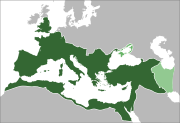
Another major influence on Europe came from the Roman Empire which left its mark on law, language, engineering, architecture, and government. During the pax romana, the Roman Empire expanded to encompass the entire Mediterranean Basin and much of Europe. Stoicism influenced emperors such as Hadrian, Antoninus Pius, and Marcus Aurelius, who all spent time on the Empire's northern border fighting Germanic, Pictish and Scottish tribes. Christianity was eventually legitimized by Constantine I after three centuries of imperial persecution.
Dark Ages
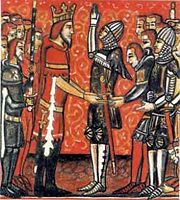
During the decline of the Roman Empire, Europe entered a long period of change arising from what historians call the " Age of Migrations". There were numerous invasions and migrations amongst the Ostrogoths, Visigoths, Goths, Vandals, Huns, Franks, Angles, Saxons, and, later still, the Vikings and Normans. Renaissance thinkers such as Petrarch would later refer to this as the "Dark Ages". Isolated monastic communities were the only places to safeguard and compile written knowledge accumulated previously; apart from this very few written records survive and much literature, philosophy, mathematics, and other thinking from the classical period disappeared from Europe.
During the Dark Ages, the Western Roman Empire fell under the control of Celtic, Slavic and Germanic tribes. The Celtic tribes established their kingdoms in Gaul, the predecessor to the Frankish kingdoms that eventually became France. The Germanic and Slav tribes established their domains over Central and Eastern Europe respectively. Eventually the Frankish tribes were united under Clovis I. Charlemagne, a Frankish king of the Carolingian dynasty who had conquered most of Western Europe, was anointed "Holy Roman Emperor" by the Pope in 800. This led to the founding of the Holy Roman Empire, which eventually became centred in the German principalities of central Europe.
The Eastern Roman Empire became known in the west as the Byzantine Empire. Based in Constantinople, they viewed themselves as the natural successors to the Roman Empire. Emperor Justinian I presided over Constantinople's first golden age: he established a legal code, funded the construction of the Hagia Sophia and brought the Christian church under state control. Fatally weakened by the sack of Constantinople during the Fourth Crusade, the Byzantines fell in 1453 when they were conquered by the Ottoman Empire.
Middle Ages
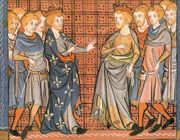
The Middle Ages were dominated by the two upper echelons of the social structure: the nobility and the clergy. Feudalism developed in France in the Early Middle Ages and soon spread throughout Europe. The struggle between the nobility and the monarchy in England led to the writing of the Magna Carta and the establishment of a parliament. The primary source of culture in this period came from the Roman Catholic Church. Through monasteries and cathedral schools, the Church was responsible for education in much of Europe.
The Papacy reached the height of its power during the High Middle Ages. The East-West Schism in 1054 split the former Roman Empire religiously, with the Eastern Orthodox Church in the Byzantine Empire and the Roman Catholic Church in the former Western Roman Empire. In 1095 Pope Urban II called for a crusade against Muslims occupying Jerusalem and the Holy Land. In Europe itself, the Church organized the Inquisition against heretics. In Spain, the Reconquista concluded with the fall of Granada in 1492, ending over seven centuries of Muslim rule in the Iberian Peninsula.
In the 11th and 12th centuries, constant incursions by nomadic Turkic tribes, such as the Kipchaks and the Pechenegs, caused a massive migration of Slavic populations to the safer, heavily forested regions of the north. Like many other parts of Eurasia, these territories were overrun by the Mongols. The invaders, later known as Tatars, formed the state of the Golden Horde, which ruled the southern and central expanses of Russia for over three centuries.
Europe was devastated in the mid-14th century by the Black Death, one of the most deadly pandemics in human history which killed an estimated 50 million people in Europe alone - a third of the European population at the time. This had a devastating effect on Europe's social structure; it induced people to live for the moment as illustrated by Giovanni Boccaccio in The Decameron (1353). It was a serious blow to the Roman Catholic Church and led to increased persecution of Jews, foreigners, beggars and lepers.
Early modern period
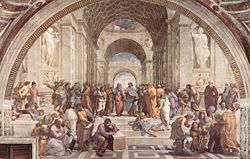
The Renaissance was a period of cultural change originating in Italy in the fourteenth century. The rise of a new humanism was accompanied by the recovery of forgotten classical and Arabic knowledge from monastic libraries and the Islamic world. The Renaissance spread across Europe between the 14th and 16th centuries: it saw the flowering of art, philosophy, music, and the sciences, under the joint patronage of royalty, the nobility, the Roman Catholic Church, and an emerging merchant class. Patrons in Italy, including the Medici family of Florentine bankers and the Popes in Rome, funded prolific quattrocento and cinquecento artists such as Raphael, Michelangelo, and Leonardo da Vinci.
Political intrigue within the Church in the mid-14th century caused the Great Schism. During this forty-year period, two popes—one in Avignon and one in Rome—claimed rulership over the Church. Although the schism was eventually healed in 1417, the papacy's spiritual authority had suffered greatly. The Church's power was further weakened by the Protestant Reformation of Martin Luther, a result of the lack of reform within the Church. The Reformation also damaged the Holy Roman Empire's power, as German princes became divided between Protestant and Roman Catholic faiths. This eventually led to the Thirty Years War (1618-1648), which crippled the Holy Roman Empire and devastated much of Germany. In the aftermath of the Peace of Westphalia, France rose to predominance within Europe.
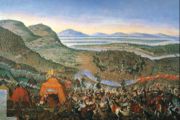
The Renaissance and the New Monarchs marked the start of an Age of Discovery, a period of exploration, invention, and scientific development. In the 15th century, Portugal and Spain, two of the greatest naval powers of the time, took the lead in exploring the world. Christopher Columbus reached the New World in 1492, and soon after the Spanish and Portuguese began establishing colonial empires in the Americas. France, the Netherlands and England soon followed in building large colonial empires with vast holdings in Africa, the Americas, and Asia.
18th and 19th centuries
The Age of Enlightenment was a powerful intellectual movement of the eighteenth century in which scientific and reason-based thought predominated. Discontent with the aristocracy and clergy's monopoly on political power in France resulted in the French Revolution and the establishment of the First Republic: the monarchy and many of the nobility perished during the initial reign of terror. Napoleon Bonaparte rose to power in the aftermath of the French Revolution and established the First French Empire that, during the Napoleonic Wars, grew to encompass large parts of Europe before collapsing in 1815 with the Battle of Waterloo.
Napoleonic rule resulted in the further dissemination of the ideals of the French Revolution, including that of nation-state, as well as the widespread adoption of the French model for administration, law and education. The Congress of Vienna was convened after Napoleon's downfall. It established a new balance of power in Europe centred on the five " great powers": the United Kingdom, France, Prussia, Habsburg Austria and Russia. This balance would remain in place until the Revolutions of 1848, during which liberal uprisings affected all of Europe except for Russia and Great Britain. The revolutions were eventually put down by more conservative elements and few reforms resulted. In 1867 the Austro-Hungarian empire was formed; and 1871 saw the unifications of both Italy and Germany as nation-states from smaller principalities.
The Industrial Revolution started in Great Britain in the last part of the 18th century and spread throughout Europe. The invention and implementation of new technology resulted in rapid urban growth, mass employment and the rise of a new working class. Reforms in social and economic spheres followed, including the first laws on child labour, the legalization of Trade Unions and the abolition of slavery. In Britain the Public Health Act of 1875 was passed, which significantly improved living conditions in many British cities.
20th century to present
Two World Wars and an economic depression dominated the first half of the 20th century. World War I was fought between 1914 and 1918. It started when Archduke Franz Ferdinand of Austria was assassinated by Gavrilo Princip. Most European nations were drawn into the war, which was fought between the Entente Powers (consisting of France, Russia and the United Kingdom (and by default its Empire), joined later by Italy and the United States) and the Central Powers (led by Austria-Hungary, Germany and the Ottoman Empire). The War left around 40 million civilians and military dead. Over 60 million European soldiers were mobilized from 1914 – 1918. Partly as a result of its defeat Russia was plunged into the Russian Revolution, which threw down the Tsarist monarchy and replaced it with the communist Soviet Union. Austria-Hungary and the Ottoman Empire collapsed and broke up into separate nations, and many other nations had their borders redrawn. The Treaty of Versailles, which officially ended World War I in 1919, was harsh towards Germany, upon whom it placed full responsibility for the war and imposed heavy sanctions.
Economic instability, caused in part by debts incurred in the First World War and 'loans' to Germany played havoc in Europe in the late 1920s and 1930s. This and the Wall Street Crash of 1929 brought about the worldwide Great Depression. Helped by the economic crisis Fascist movements developed throughout Europe placing Adolf Hitler of Nazi Germany, Francisco Franco of Spain and Benito Mussolini of Italy in power.
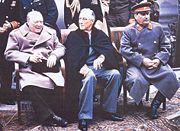
Driven by his ideals of war and power, Hitler started expanding Germany steadily after coming to authority in 1933. The Saarland was incorporated in 1935 and Austria with the so-called Anschluss in 1938. Later in 1938 the Sudetenland was annexed in a move that was highly contested by the other powers, but ultimately permitted in hopes of appeasing Hitler. In early 1939, the remainder of Czechoslovakia was split into the Protectorate of Bohemia and Moravia, incorporated in Nazi Germany, and the Slovac satellite state. The German invasion of Poland on 1 September 1939, prompted France and the United Kingdom to declare war to Germany on 3 September. The Soviet invasion of Poland and the Baltic countries started on 17 September. After occupying the Low Countries, Denmark and Norway quickly, Germany forced French capitulation in June 1940. However, the subsequent bombing offensive on Britain determined the first failure to Germany's bellicose operations. In 1941 Germany turned on their former Soviet allies with an ultimately unsuccessful invasion of the Soviet Union. On 7 December 1941 Japan's surprise attack on Pearl Harbour drew the United States into the conflict as allies of the British Empire and other allied forces. After the staggering battle of Stalingrad in 1943, the German offensive on Soviet territory turned into a continual fallback. In 1944 British and American forces invaded France in the D-Day landings opening a second front on Germany. Berlin finally fell in 1945, ending World War II in Europe. The war was the largest and most destructive in human history, with 60 million dead across the world, including between 9 and 11 million people who perished during the Holocaust.

World War I and especially World War II diminished the eminence of Western Europe in world affairs. After World War II the map of Europe was redrawn at the Yalta Conference and divided into two blocs, the Western countries and the communist Eastern bloc, separated by what was later called by Winston Churchill an "iron curtain". The United States and Western Europe established the NATO alliance and later the Soviet Union and Eastern Europe established the Warsaw Pact. The two new superpowers, the United States and the Soviet Union, became locked in a fifty-year long Cold War, centred on nuclear proliferation. At the same time decolonization, which had already started after World War I, gradually resulted in the independence of most of the European colonies in Asia and Africa. In the 1980s the reforms of Mikhail Gorbachev and the solidarity movement in Poland accelerated the collapse of the Eastern bloc and the end of the Cold War. Germany was reunited, after the symbolic fall of the Berlin Wall in 1989, and the maps of Eastern Europe were redrawn once more.
European integration also grew in the post-World War II years. The Treaty of Rome in 1957 established the European Economic Community between six Western European states with the goal of a unified economic policy and common market. In 1967 the EEC, European Coal and Steel Community and Euratom formed the European Community, which in 1993 became the European Union. The EU established a parliament, court and central bank and introduced the euro as a unified currency. Beginning in the 1990s after the end of the Cold War, Eastern European countries began joining, expanding the EU to its current size of 27 European nations, and once more making Europe a major economical and political centre of power.
Geography and extent
Physiographically, Europe is the northwestern constituent of the larger landmass known as Eurasia, or Afro-Eurasia: Asia occupies the eastern bulk of this continuous landmass and all share a common continental shelf. Europe's eastern frontier is now commonly delineated by the Ural Mountains in Russia. The first century AD geographer Strabo, took the Tanais River to be the boundary, as did early Judaic sources. The southeast boundary with Asia is not universally defined. Most commonly the Ural or, alternatively, the Emba River serve as possible boundaries. The boundary continues to the Caspian Sea, the crest of the Caucasus Mountains or, alternatively, the Kura River in the Caucasus, and on to the Black Sea; the Bosporus, the Sea of Marmara, and the Dardanelles conclude the Asian boundary. The Mediterranean Sea to the south separates Europe from Africa. The western boundary is the Atlantic Ocean; Iceland, though nearer to Greenland (North America) than mainland Europe, is generally included in Europe. There is ongoing debate on where the geographical centre of Europe is. For a detailed description of the boundary between Asia and Europe see transcontinental nation.
Because of sociopolitical and cultural differences, there are various descriptions of Europe's boundary; in some sources, some territories are not included in Europe, while other sources include them. For instance, geographers from Russia and other post-Soviet states generally include the Urals in Europe while including Caucasia in Asia. Similarly, numerous geographers consider Azerbaijan's and Armenia's southern border with Iran and Turkey's southern and eastern border with Syria, Iraq and Iran as the boundary between Asia and Europe because of political and cultural reasons. In the same way, despite being close to Asia and Africa, the Mediterranean islands of Cyprus and Malta are generally considered part of Europe.
Physical geography
Land relief in Europe shows great variation within relatively small areas. The southern regions, however, are more mountainous, while moving north the terrain descends from the high Alps, Pyrenees and Carpathians, through hilly uplands, into broad, low northern plains, which are vast in the east. This extended lowland is known as the Great European Plain, and at its heart lies the North German Plain. An arc of uplands also exists along the north-western seaboard, which begins in the western parts of the islands of Britain and Ireland, and then continues along the mountainous, fjord-cut, spine of Norway.
This description is simplified. Sub-regions such as the Iberian Peninsula and the Italian Peninsula contain their own complex features, as does mainland Central Europe itself, where the relief contains many plateaus, river valleys and basins that complicate the general trend. Sub-regions like Iceland, Britain and Ireland are special cases. The former is a land unto itself in the northern ocean which is counted as part of Europe, while the latter are upland areas that were once joined to the mainland until rising sea levels cut them off.
Climate

tundra alpine tundra taiga montane forest
temperate broadleaf forest mediterranean forest temperate steppe dry steppe

Europe lies mainly in the temperate climate zones, being subjected to prevailing westerlies.
The climate is milder in comparison to other areas of the same latitude around the globe due to the Gulf Stream. The Gulf Stream is nicknamed "Europe's central heating", because it makes Europe's climate warmer and wetter than it would otherwise be. The Gulf Stream not only carries warm water to Europe's coast but also warms up the prevailing westerly winds that blow across the continent from the Atlantic Ocean.
Therefore the average temperature throughout the year of Naples is 16 °C (60.8 °F), while it is only 12 °C (53.6 °F) in New York City which is almost on the same latitude. Berlin, Germany; Calgary, Canada; and Irkutsk, in the Asian part of Russia, lie on around the same latitude; January temperatures in Berlin average around 8 °C (15 °F) higher than those in Calgary, and they are almost 22 °C (40 °F) higher than average temperatures in Irkutsk.
Geology
The Geology of Europe is hugely varied and complex, and gives rise to the wide variety of landscapes found across the continent, from the Scottish Highlands to the rolling plains of Hungary.
Europe's most significant feature is the dichotomy between highland and mountainous Southern Europe and a vast, partially underwater, northern plain ranging from England in the west to Ural Mountains in the east. These two halves are separated by the mountain chains of the Pyrenees and Alps/ Carpathians. The northern plains are delimited in the west by the Scandinavian Mountains and the mountainous parts of the British Isles. Major shallow water bodies submerging parts of the northern plains are the Celtic Sea, the North Sea, the Baltic Sea complex and Barents Sea.
The northern plain contains the old geological continent of Baltica, and so may be regarded geologically as the "main continent", while peripheral highlands and mountainous regions in the south and west constitute fragments from various other geological continents. Most of the older geology of Western Europe existed as part of the ancient microcontinent Avalonia.
Geological history
The geological history of Europe traces back to the formation of the Baltic Shield (Fennoscandia) and the Sarmatian craton, both around 2250 million years ago, followed by the Volgo-Uralia shield, the three together leading to the East European craton (≈ Baltica) which became a part of the supercontinent Columbia. Around 1100 million years ago, Baltica and Arctica (as part of the Laurentia block) became joined to Rodinia, later resplitting around 550 million years ago to reform as Baltica. Around 440 million years ago Euramerica was formed from Baltica and Laurentia; a further joining with Gondwana then leading to the formation of Pangea. Around 190 million years ago, Gondwana and Laurasia split apart due to the widening of the Atlantic Ocean. Finally, and very soon afterwards, Laurasia itself split up again, into Laurentia (North America) and the Eurasian continent. The land connection between the two persisted for a considerable time, via Greenland, leading to interchange of animal species. From around 50 million years ago, rising and falling sea levels have determined the actual shape of Europe, and its connections with continents such as Asia. Europe's present shape dates to the late Tertiary period about five million years ago.
Biodiversity
Having lived side-by-side with agricultural peoples for millennia, Europe's animals and plants have been profoundly affected by the presence and activities of man. With the exception of Fennoscandia and northern Russia, few areas of untouched wilderness are currently found in Europe, except for various national parks.
The main natural vegetation cover in Europe is mixed forest. The conditions for growth are very favourable. In the north, the Gulf Stream and North Atlantic Drift warm the continent. Southern Europe could be described as having a warm, but mild climate. There are frequent summer droughts in this region. Mountain ridges also affect the conditions. Some of these ( Alps, Pyrenees) are oriented east-west and allow the wind to carry large masses of water from the ocean in the interior. Others are oriented south-north ( Scandinavian Mountains, Dinarides, Carpathians, Apennines) and because the rain falls primarily on the side of mountains that is oriented towards sea, forests grow well on this side, while on the other side, the conditions are much less favourable. Few corners of mainland Europe have not been grazed by livestock at some point in time, and the cutting down of the pre-agricultural forest habitat caused disruption to the original plant and animal ecosystems.
Probably eighty to ninety per cent of Europe was once covered by forest. It stretched from the Mediterranean Sea to the Arctic Ocean. Though over half of Europe's original forests disappeared through the centuries of deforestation, Europe still has over one quarter of its land area as forest, such as the taiga of Scandinavia and Russia, mixed rainforests of the Caucasus and the Cork oak forests in the western Mediterranean. During recent times, deforestation has been slowed and many trees have been planted. However, in many cases monoculture plantations of conifers have replaced the original mixed natural forest, because these grow quicker. The plantations now cover vast areas of land, but offer poorer habitats for many European forest dwelling species which require a mixture of tree species and diverse forest structure. The amount of natural forest in Western Europe is just 2–3% or less, in European Russia 5–10%. The country with the smallest percentage of forested area (excluding the micronations) is Iceland (1%), while the most forested country is Finland (77%).
In temperate Europe, mixed forest with both broadleaf and coniferous trees dominate. The most important species in central and western Europe are beech and oak. In the north, the taiga is a mixed spruce-pine- birch forest; further north within Russia and extreme northern Scandinavia, the taiga gives way to tundra as the Arctic is approached. In the Mediterranean, many olive trees have been planted, which are very well adapted to its arid climate; Mediterranean Cypress is also widely planted in southern Europe. The semi-arid Mediterranean region hosts much scrub forest. A narrow east-west tongue of Eurasian grassland (the steppe) extends eastwards from Ukraine and southern Russia and ends in Hungary and traverses into taiga to the north.
Glaciation during the most recent ice age and the presence of man affected the distribution of European fauna. As for the animals, in many parts of Europe most large animals and top predator species have been hunted to extinction. The woolly mammoth was extinct before the end of the Neolithic period. Today wolves (carnivores) and bears ( omnivores) are endangered. Once they were found in most parts of Europe. However, deforestation and hunting caused these animals to withdraw further and further. By the Middle Ages the bears' habitats were limited to more or less inaccessible mountains with sufficient forest cover. Today, the brown bear lives primarily in the Balkan peninsula, Scandinavia, and Russia; a small number also persist in other countries across Europe (Austria, Pyrenees etc.), but in these areas brown bear populations are fragmented and marginalised because of the destruction of their habitat. In addition, polar bears may be found on Svalbard, a Norwegian archipelago far north of Scandinavia. The wolf, the second largest predator in Europe after the brown bear, can be found primarily in Eastern Europe and in the Balkans, with a handful of packs in pockets of Western Europe ( Scandinavia, Spain, etc.).
Other important European carnivores are Eurasian lynx, European wild cat, foxes (especially the red fox), jackal and different species of martens, hedgehogs, different species of reptiles (like snakes as ( vipers and grass snakes) and amphibians, different birds (owls, hawks and other birds of prey).
Important European herbivores are snails, larvae, fish, different birds, and mammals, like rodents, deer and roe deer, boars, and living in the mountains, marmots, steinbocks, chamois among others.
Sea creatures are also an important part of European flora and fauna. The sea flora is mainly phytoplankton. Important animals that live in European seas are zooplankton, molluscs, echinoderms, different crustaceans, squids and octopuses, fish, dolphins, and whales.
Biodiversity is protected in Europe through the Council of Europe's Bern Convention), which has also been signed by the European Community as well as non-European states.
Demographics
Since the Renaissance, Europe has had a major influence in culture, economics and social movements in the world. European demographics are important not only historically, but also in understanding current international relations and population issues.
Some current and past issues in European demographics have included religious emigration, race relations, economic immigration, a declining birth rate and an aging population. In some countries, such as Ireland and Poland, access to abortion is currently limited; in the past, such restrictions and also restrictions on artificial birth control were commonplace throughout Europe. Furthermore, three European countries (The Netherlands, Belgium and Switzerland) have allowed a limited form of voluntary euthanasia for some terminally ill people.
In 2005 the population of Europe was estimated to be 731 million according to the United Nations, which is slightly more than one-ninth of the world's population. A century ago Europe had nearly a quarter of the world's population. The population of Europe has grown in the past century, but in other areas of the world (in particular Africa and Asia) the population has grown far more quickly. According to UN population projection (medium variant), Europe's share will fall to 7% in 2050, numbering 653 million. Within this context, significant disparities exist between religions in relation to fertility rates. The average number of children per female of child bearing age is 1.52. According to some sources, this rate is higher among Muslims. In 2005 the EU had an overall net gain from immigration of 1.8 million people, despite having one of the highest population densities in the world. This accounted for almost 85% of Europe's total population growth. A tough new EU immigration law detaining illegal immigrants for up to 18 months before deportation has triggered outrage across Latin America, with Venezuelan President Hugo Chavez threatening to cut off oil exports to Europe.
Political geography
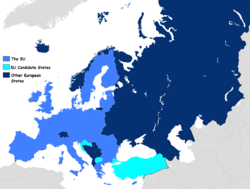
According to different definitions, the territories may be subject to various categorisations. The table below shows the scheme for geographic subregions used by the United Nations, alongside the regional grouping published in the CIA factbook. The socio-geographical data included are per sources in cross-referenced articles. Where they differ, provisos are clearly indicated.
The 27 European Union member states are highly integrated economically and politically, the European Union itself forms part of the political geography of Europe.
| Name of region and territory, with flag |
Area (km²) |
Population (1 July, 2002 est.) |
Population density (per km²) |
Capital |
|---|---|---|---|---|
| 1,552 | 26,008 | 16.8 | Mariehamn | |
| 28,748 | 3,600,523 | 125.2 | Tirana | |
| 468 | 68,403 | 146.2 | Andorra la Vella | |
| 83,858 | 8,169,929 | 97.4 | Vienna | |
| 29,800 | 3,229,900 | 101 | Yerevan | |
| 86,600 | 8,621,000 | 97 | Baku | |
| 207,600 | 10,335,382 | 49.8 | Minsk | |
| 30,510 | 10,274,595 | 336.8 | Brussels | |
| 51,129 | 4,448,500 | 77.5 | Sarajevo | |
| 110,910 | 7,621,337 | 68.7 | Sofia | |
| 56,542 | 4,437,460 | 77.7 | Zagreb | |
| 9,251 | 788,457 | 85 | Nicosia | |
| 78,866 | 10,256,760 | 130.1 | Prague | |
| 43,094 | 5,368,854 | 124.6 | Copenhagen | |
| 45,226 | 1,415,681 | 31.3 | Tallinn | |
| 1,399 | 46,011 | 32.9 | Tórshavn | |
| 336,593 | 5,157,537 | 15.3 | Helsinki | |
| 547,030 | 59,765,983 | 109.3 | Paris | |
| 69,700 | 4,661,473 | 64 | Tbilisi | |
| 357,021 | 83,251,851 | 233.2 | Berlin | |
| 5.9 | 27,714 | 4,697.3 | Gibraltar | |
| 131,940 | 10,645,343 | 80.7 | Athens | |
| 78 | 64,587 | 828.0 | St. Peter Port | |
| 93,030 | 10,075,034 | 108.3 | Budapest | |
| 103,000 | 307,261 | 2.7 | Reykjavík | |
| 70,280 | 4,234,925 | 60.3 | Dublin | |
| 572 | 73,873 | 129.1 | Douglas | |
| 301,230 | 58,751,711 | 191.6 | Rome | |
| 116 | 89,775 | 773.9 | Saint Helier | |
| 2,724,900 | 15,217,711 | 5.6 | Astana | |
| 10,887 | 2,126,708 | 220 | Pristina | |
| 64,589 | 2,366,515 | 36.6 | Riga | |
| 160 | 32,842 | 205.3 | Vaduz | |
| 65,200 | 3,601,138 | 55.2 | Vilnius | |
| 2,586 | 448,569 | 173.5 | Luxembourg | |
| 25,333 | 2,054,800 | 81.1 | Skopje | |
| 316 | 397,499 | 1,257.9 | Valletta | |
| 33,843 | 4,434,547 | 131.0 | Chişinău | |
| 1.95 | 31,987 | 16,403.6 | Monaco | |
| 13,812 | 616,258 | 44.6 | Podgorica | |
| 41,526 | 16,318,199 | 393.0 | Amsterdam | |
| 324,220 | 4,525,116 | 14.0 | Oslo | |
| 312,685 | 38,625,478 | 123.5 | Warsaw | |
| 91,568 | 10,409,995 | 110.1 | Lisbon | |
| 238,391 | 21,698,181 | 91.0 | Bucharest | |
| 17,075,400 | 142,200,000 | 26.8 | Moscow | |
| 61 | 27,730 | 454.6 | San Marino | |
| 88,361 | 9,663,742 | 109.4 | Belgrade | |
| 48,845 | 5,422,366 | 111.0 | Bratislava | |
| 20,273 | 1,932,917 | 95.3 | Ljubljana | |
| 504,851 | 45,061,274 | 89.3 | Madrid | |
Mayen Islands (Norway) |
62,049 | 2,868 | 0.046 | Longyearbyen |
| 449,964 | 9,090,113 | 19.7 | Stockholm | |
| 41,290 | 7,507,000 | 176.8 | Bern | |
| 783,562 | 70,586,256 | 93 | Ankara | |
| 603,700 | 48,396,470 | 80.2 | Kiev | |
| 244,820 | 61,100,835 | 244.2 | London | |
| 0.44 | 900 | 2,045.5 | Vatican City | |
| Total | 10,180,000 | 731,000,000 | 70 |
Economy

As a continent, the economy of Europe is currently the largest on Earth. As with other continents, Europe has a large variation of wealth among its countries. The richer states tend to be in the West, some of the Eastern economies are still emerging from the collapse of the Soviet Union and Yugoslavia. The European Union, an intergovernmental body composed of 27 European states, comprises the largest single economic area in the world. Currently, 15 EU countries share the euro as a common currency. Five European countries rank in the top ten of the worlds largest national economies in GDP (PPP). This includes (ranks according to the CIA): Germany (5), the UK (6), Russia (7), France (8), and Italy (10).
Pre–1945: Industrial growth
The Industrial Revolution started in Europe, specifically the United Kingdom in the late 18th century, and the 19th century saw Western Europe industrialise. Economies were disrupted by World War I but by the beginning of World War II they had recovered and were having to compete with the growing economic strength of the United States. World War II, again, damaged much of Europe's industries.
1945–1990: The Cold War
After World War II the economy of the UK was in a state of ruin, and continued to suffer relative economic decline in the following decades. Italy was also in a poor economic condition but regained a high level of growth by the 1950s. West Germany recovered quickly and had doubled production from pre-war levels by the 1950s. France also staged a remarkable comeback enjoying rapid growth and modernisation. The majority of Eastern European states came under the control of the USSR and thus were members of the Council for Mutual Economic Assistance (COMECON). The states which retained a free-market system were given a large amount of aid by the United States under the Marshall Plan. The western states moved to link their economies together, providing the basis for the EU and increasing cross border trade. This helped them to enjoy rapidly improving economies, while those states in COMECON were struggling in a large part due to the cost of the Cold War. Until 1990, the European Community was expanded from 6 founding members to 12. The emphasis placed on resurrecting the West German economy led to it overtaking the UK as Europe's largest economy.
1991–2003: The rise of the EU
With the fall of communism in Eastern Europe in 1991 the Eastern states had to adapt to a free market system. There were varying degrees of success with Central European countries such as Poland, Hungary, and Slovenia adapting reasonably quickly, while eastern states like Ukraine and Russia taking far longer. Western Europe helped Eastern Europe by forming economic ties with them. After East and West Germany were reunited in 1990, the economy of West Germany struggled as it had to support and largely rebuild the infrastructure of East Germany. Yugoslavia lagged farthest behind as it was ravaged by war and in 2003 there were still many EU and NATO peacekeeping troops in Kosovo, Macedonia, and Bosnia-Herzegovina, with only Slovenia making any real progress. By the millennium change, the EU dominated the economy of Europe comprising the five largest European economies of the time namely Germany, the United Kingdom, France, Italy, and Spain. In 1999 12 of the 15 members of the EU joined the Eurozone replacing their former national currencies by the common euro. The three who chose to remain outside the Eurozone were: the United Kingdom, Denmark, and Sweden.
Language
European languages mostly fall within three Indo-European language groups: the Romance languages, derived from the Latin language of the Roman Empire; the Germanic languages, whose ancestor language came from southern Scandinavia; and the Slavic languages. While having much of its vocabulary descended from Romance languages, the English language is a Germanic language.
Romance languages are spoken primarily in south-western Europe as well as in Romania and Moldova. Germanic languages are spoken in north-western Europe and some parts of Central Europe. Slavic languages are spoken in Central, Eastern, and Southeastern Europe.
Many other languages outside the three main groups exist in Europe. Other Indo-European languages include the Baltic group (i.e., Latvian and Lithuanian), the Celtic group (i.e., Irish, Scottish Gaelic, Manx, Welsh, Cornish, and Breton), Greek, Albanian, and Armenian. A distinct group of Uralic languages are Estonian, Finnish, and Hungarian, spoken in the respective countries as well as in parts of Romania, Russia, Serbia, and Slovakia. Other Non-Indo-European languages are Basque, Georgian, Azerbaijani, and languages of minority nations in Russia.
Multilingualism and the protection of regional and minority languages are recognized political goals in Europe today. The Council of Europe Framework Convention for the Protection of National Minorities and the Council of Europe's European Charter for Regional or Minority Languages set up a legal framework for language rights in Europe.
Religion
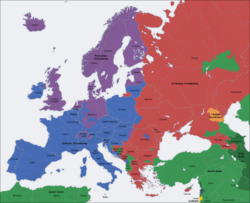
Historically, religion in Europe has been a major influence on European art, culture, philosophy and law. The majority religion in Europe is Christianity and then Islam concentrated mainly in the south west (Bosnia and Herzegovina, Albania, Kosovo and Turkey). Other religions including Judaism, Hinduism and Buddhism are minority religions. Europe is a relatively secular continent and has the largest number and proportion of irreligious, agnostic and atheistic people in the Western world, with a particularly high number of self-described non-religious people in the Czech Republic, Estonia, Sweden and France.
Culture
The culture of Europe can be described as a series of overlapping cultures. Whether it is a question of West and East; Christianity and Islam; cultural mixes exist across the continent. There are cultural innovations and movements, sometimes at odds with each other, such as Christian proselytism or Humanism. Thus the question of "common culture" or "common values" is complex.
